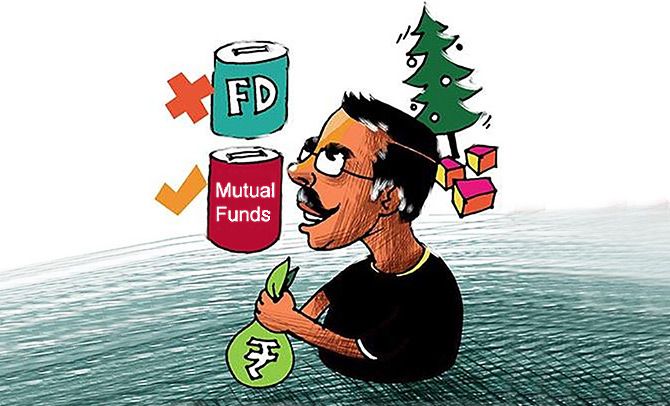Most financial planners believe that destabilising your portfolio, just for the sake of a quick buck, will not bring excessive incremental returns.
Illustration: Uttam Ghosh/Rediff.com.

Financial planners are a worried lot nowadays. With an almost secular rally in the stock markets, and the Nifty50 at over 10,000 points, investors who have maintained a good part of their portfolio in fixed deposits for years are now enquiring if it makes sense to move money from these instruments to equity-oriented balanced funds or monthly income plans (MIPs).
It also seems that many distributors are encouraging this move.
"We hear that even many distributors are aggressively promoting these schemes to customers," says Suresh Sadagopan, a certified financial planner.
Clearly, the saying that risk perception goes down when the markets are up is very much in evidence today.
Sadagopan believes that since longer-term debt funds offer 0.5-1.5 per cent more than fixed deposits, they are totally liquid and tax-efficient. They are useful for those in higher tax brackets. But he doesn't approve of this blind movement from safer instruments to riskier ones.
Most financial planners would agree.
Earning greater returns on one's portfolio isn't a bad idea. But messing with the portfolio by going all out on equity-heavy instruments could hurt investors.
Financial planners emphasise the significance of asset allocation.
"You can't just shift the money in fixed deposits, which are part of your debt portfolio, into equities, without taking into account your goals, time horizon and risk appetite," says Amar Pandit, founder and chief executive officer, My Financial Advisor.
Keep fool-proof instruments
Yes, there is no denying that it feels good when your investment doubles in one or two years. And debt instruments fail that test.
The returns at 6.5-7.5 per cent from a bank fixed deposit a year means the investment will only double in 9.5-11 years. But at the same time, the value of your investment can halve in less than a few months, if there is a sharp correction in equities.
During those lean periods, even keeping money idle in savings deposit accounts, which earn a nominal 3.5-6 per cent, seems significant.
"Keeping money in debt, especially fixed deposits, will ensure that there is some stability to the portfolio during lean market periods," says Pandit.
Let's look at balanced funds and MIPs, the favourite options now for some risk-averse investors, a little more closely.
Balanced funds
Typically, balanced funds are targeted towards investors who are looking for a mixture of safety and modest capital appreciation. Balanced funds invest 65 per cent or more in equities. This allows these schemes to get tax benefits akin to equity funds -- 15 per cent on short-term capital gains tax (less than one year) and zero on long-term capital gains (after more than a year).
The tax benefit is an added selling point because higher returns coupled with low lock-in period for tax benefits interests many investors.
Advice for investors
It may not be a very good idea to shift money from fixed deposits to balanced funds. The equity component in some of these schemes rises as high as 75-80 per cent.
"If you must shift from fixed deposits to balanced funds, do so very gradually and spread over a few years," says Deepesh Raghaw, founder, PersonalFinancePlan.in, a Sebi-registered investment advisor (RIA).
Also, bear in mind that in the recent past both fixed-income and equity components of balanced funds have done well (the former due to falling interest rates).
"Investors who expect those high returns from balanced funds to get repeated are likely to be disappointed," says Vishal Dhawan, chief financial planner, Plan Ahead Wealth Advisors.
Moreover, 2017 has been a year of very low volatility in equities. Experts say that this sense of complacency has spread to investors in balanced funds as well.
"Since returns can be negative in certain years, enter it with at least a five-year horizon," says Dhawan.
Monthly income plans (MIPs)
They are debt schemes which invest a small part of their corpus (15-25 per cent) in equities. These schemes try to offer regular income in the form of periodic (monthly, quarterly, half-yearly) dividend payouts.
Even though they are much safer than balanced funds, the 15-25 per cent equity element can make them volatile, if there is a sharp drop in the market.
"In those years, the negative returns from equities wipe out whatever gains you have made on the fixed-income side as well," says Dhawan.
Their returns are more conservative because of the high debt allocation.
"One disadvantage of a hybrid product like MIPs is that here even the equity portion of 15-25 per cent gets debt-like treatment for tax purposes," says Raghaw.
Another is that their expense ratio is quite high. Financial planners suggest that investors would be better off creating their own MIPs by investing 75-85 per cent in debt funds and 15-25 per cent in equities. With such a structure they will also be able to enjoy the tax treatment on the equity portion.
Advice for investors
If you are moving your money from bank fixed deposits to equities, this is a comparatively safer route. If you choose the dividend option, there will be a dividend distribution tax.
Whereas the dividend earned is tax-free in the hands of the investor, the dividend distribution tax is 28.8 per cent. This is paid by the fund house at the time of declaring the dividend.
Don't mess with your portfolio
The main problem, according to financial experts, with moving money from fixed deposits to these schemes is that it increases volatility in the portfolio. Most financial planners believe that destabilising your portfolio, just for the sake of a quick buck, will not bring excessive incremental returns.
For example: Assuming a portfolio with 60 per cent in equities and 40 per cent in fixed deposits. If the equity portion earns 30 per cent annual returns and the debt (40 per cent) earns seven per cent, the annual return of the portfolio will be 20.8 per cent, a significant number when the Consumer Price Index-based inflation is hovering at around four-five per cent.
Now, if you move another 20 per cent to balanced funds, which earns 20 per cent annually, the return would improve to 23.4 per cent. But, if the balanced fund part falls by half, then all the gains made on the other two portions (keeping equity and fixed deposit returns constant at 30 per cent and eight per cent, respectively), will decrease significantly.
The overall portfolio returns would fall to 9.4 per cent.
In other words, there is too much risk being taken for too little benefit. It is advisable to stay put with your current portfolio allocation that puts 40 per cent in pure and safe fixed deposits.








 © 2025
© 2025